Pager (Credit: The Guardian)
How did Israeli Occupation Forces trigger Hezbollah’s device explosions?
A recent Israeli Occupation cyberattack on Hezbollah’s communication devices (pagers) in Lebanon and Syria led to the deaths of eight people and injuries to more than 2,800 others, according to reports.
Asharq Al-Awsat cited telecommunications expert Amer Al-Tabsh, who provided further insight into the cyberattack.
Tabsh explained that the Israeli Occupation Forces (IOF) likely discovered the frequency Hezbollah used for communication.
The breach specifically targeted their devices, leaving other similar equipment used by security forces and hospitals unaffected.
The expert clarified that each frequency band has a limited capacity, and by overloading it with data, the connected devices overheated, causing their batteries to explode.
In some cases, the devices reached temperatures as high as 120°C.
Many of these devices, which use lithium batteries, can be highly dangerous when they overheat, potentially causing severe injuries or fatalities, especially since they are typically worn on the waist.
Al-Tabsh further explained that pagers were once widely used in the 1990s, particularly by doctors and security personnel. For example, an emergency code like 911 could be sent to alert doctors to a crisis.
He added that following Hezbollah's decision to ban the use of cell phones among its members, there were reports that key members were given pagers for emergency communication and mission alerts.
The cyberattack has prompted further investigations by Hezbollah to determine how the breaches occurred, while hospitals across southern Lebanon have been stretched beyond capacity, with many of the injured being transported to facilities outside the affected areas.




